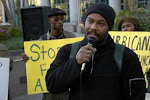Dow ends at lowest close in more than 6 years
By TIM PARADIS, AP Business Writer
1 hr 10 mins ago
NEW YORK – An important psychological barrier gave way on Wall Street Thursday as the Dow Jones industrials fell to their lowest level in more than six years. The Dow broke through a bottom reached in November, pulled down by sharp declines in key financial shares. It was the lowest ending for the Dow since Oct. 9, 2002, when the last bear market bottomed out.
The move below that level dashed hopes that the doldrums of November would mark the ending point of a long slump in the market, which is now nearly halfway below the peak levels reached in October 2007.
The market's inability to rally signals that investors see no immediate end for the recession, which is already 14 months old and one of the most severe in decades. Investors also haven't been impressed with two major economic initiatives from the Obama administration this week, an economic stimulus package and a mortgage relief plan.
"It is definitely, definitely a blow to psychology," said Quincy Krosby, chief investment strategist at The Hartford, referring to the Dow's finish. "There is more pessimism in the market as to when the economy is going to pick up steam."
The Dow had been teetering close to November bottom since Tuesday, when the index tumbled 300 points on worries about the economy and the stability of banks in Eastern Europe. Stocks had barely finished above the November low on Tuesday and Wednesday.
On Thursday, worries about financial and technology stocks weighed on the market, with steep drop-offs in financial bellwethers like Citigroup and Bank of America leading the way downward. Both stocks ended down about 14 percent.
"The Dow represents, to the average investor, the American economy," Krosby said. While professional investors often look at indexes like the Standard & Poor's 500 index, the Dow's slide is an unwelcome milestone. "It's a tenet of the market, selling begets selling. You're going to see the market on guard."
The Dow lost 89.68, or 1.2 percent, to end at 7,465.95.
The blue chips have fallen 9.8 percent in the last eight sessions.
Broader indexes also fell. The Standard & Poor's 500 index ended down 9.48, or 1.2 percent, to 778.94. The index finished above its Nov. 20 close of 752.44, which was its worst finish since April 1997.
The technology-heavy Nasdaq composite index suffered the biggest hit Thursday after Hewlett Packard Co. tumbled 7.9 percent after posting worrisome results. The Nasdaq fell 25.15, or 1.7 percent, to 1,442.82.
The Russell 2000 index of smaller companies fell 6.47, or 1.5 percent, to 416.71.
Declining issues outnumbered advancers by more than 2 to 1 on the New York Stock Exchange, where consolidated volume came to 5.64 billion shares compared with 5.65 billion shares traded Wednesday.
Dan Cook, senior market analyst at IG Markets, said the Dow's move lower is unnerving because without that level of support some investors worry there is little to keep stocks from falling farther.
"It's kind of like if we're walking across a frozen pond. If that ice starts to crack a bit we're going to be very wary," he said.
The news of the day didn't offer much support. Hewlett-Packard Co. gave up nearly 8 percent after the computer and printer company turned in disappointing fourth-quarter sales, hurt by tightening spending at many businesses.
Even the bright spots weren't enough to lift the market. Sprint Nextel Corp., the nation's third-largest wireless carrier, rose 20 percent after its fourth-quarter results came in better than forecast. And Whole Foods Market Inc. jumped 37 percent Thursday after earnings from the natural and organic grocer topped expectations.
Bond prices were mixed. The yield on the benchmark 10-year Treasury note, which moves opposite to its price, rose to 2.86 percent from 2.75 percent late Wednesday. The yield on the three-month T-bill, considered one of the safest investments, fell to 0.29 percent from 0.30 percent Wednesday.
The dollar was mixed against other major currencies, while gold prices slipped.
Light, sweet crude rose $2.77 to settle at $40.18 per barrel on the New York Mercantile Exchange.
News on the economic front was mixed, providing little guidance for a restless market.
An index of leading economic indicators logged a surprise increase in January, the second straight monthly gain, but the Philadelphia Federal Reserve said conditions in the region's manufacturing sector weakened in February. Also, a reading on wholesale prices, the Producer Price Index, jumped more than expected in January, the first increase in six months.
Technology and financial stocks weighed on the market. H-P fell $2.69, or 7.9 percent, to $31.39 after its fourth-quarter results disappointed investors.
Citigroup fell 40 cents, or 13.8 percent, to $2.51, while Bank of America fell 64 cents, or 14 percent, to $3.93.
Some investors turned to consumer staples stocks after drugstore operator CVC Caremark Corp. posted a better-than-expected 17 percent increase in earnings for the final three months of 2008. CVS rose $1.72, or 6.4 percent, to $28.71.
Sprint rose 54 cents, or 19.9 percent, to $3.25, while Whole Foods rose $3.46, or 37.2 percent, to $12.75.
Overseas, Britain's FTSE 100 rose 0.3 percent, Germany's DAX index rose 0.2 percent, and France's CAC-40 fell 0.1 percent. Japan's Nikkei stock average rose 0.3 percent.
Subscribe to:
Post Comments (Atom)




No comments:
Post a Comment